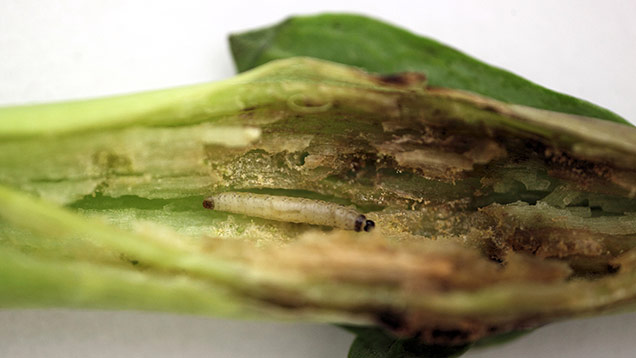Spraying pyrethroids for flea beetle larvae a ‘waste of time’
 © Blackthorn Arable
© Blackthorn Arable Growers should avoid spraying insecticide to control cabbage stem flea beetle larvae in oilseed rape to reduce the risk of killing natural predators and fuelling insecticide resistance.
Adult beetles move into crops during August and September to feed and mate, after which eggs are laid at the base of plants.
Eggs hatch if conditions are mild enough from late September, as they were last year when larval damage was significant. Then larvae move up to feed on leaf petioles and later inside the main stem behind the growing point.
According to current guidelines, growers can assess the need to spray crops for larvae by monitoring numbers of adults with four yellow water traps between early September and the end of October.
See also: Shocking contrast in neonic-treated and untreated oilseed rape
If an average greater than 96 adult beetles/trap is caught over the monitoring period, an insecticide spray for larvae is warranted.
The assessment can also be made by plant dissection or visual inspection of leaf petioles and if more than five larvae/plant or more than 50% of leaf petioles are damaged, the treatment threshold is also triggered.
However, experts agree that despite the thresholds existing, it is very difficult to target larvae with foliar insecticides, as they have to be hit before they burrow into the plant.
Cabbage stem flea beetle life cycle
Farmers Weekly asked Fera entomologist Larissa Collins to provide the latest understanding of the cabbage stem flea beetle life cycle and in particular, when eggs laid this autumn are likely to hatch.
The information provides a good guide, but Dr Collins says that continual visual monitoring of the crop for early signs of larvae burrowing into petioles is key to assessing risk.
When do eggs hatch?
- The time from adult appearance to egg laying is about 7-14 days
- The time from egg laying to egg hatch is temperature dependent
- In lab conditions at a constant temperature of 10C, egg hatch takes 37 days and below 6C, 70+ days
- Egg development does not occur below 3.2C
- 240 day degrees above 3.2C is needed for hatch under both constant and fluctuating temperatures
- In the field, egg hatch is difficult to predict
- From when adults fly in, growers should assume around 14 days to egg laying and from that point, temperature data can be used to estimate time to egg hatching.
Example estimates are:
- 70 days at a mean temperature of 6.7C
- 35 days at a mean temperature of 10.7C
- 28 days at a mean temperature of 12.5C (early sowing)
- 56 days at a mean temperature of 8.1C (late sowing)
This is due to no systemic actives being available, with the only approved products to control cabbage stem flea beetle larvae being contact-acting pyrethroids.
Models to predict peak egg hatch do exist in Germany to help target sprays, but these have not yet been adapted to work in UK conditions, so at present monitoring adults and the looking for the start of larvae damage are the only options to indicate spray timing.
Larissa Collins, senior entomologist at advisory group Fera, says that targeting the adults gives the most effective control.
However, many earlier sown oilseed rape crops have now grown out of the adult damage risk period and the threat is now the larvae hatching from eggs typically laid over a prolonged period.
“At current temperatures, we would expect about a month between egg laying and hatching, but it’s a long and drawn-out process and in my opinion is very difficult to time chemical treatment effectively,” she adds.
Moving target
Independent entomologist Alan Dewar agrees that control is tricky, with larvae having to be hit as they move across leaves and into leaf petioles.
“Regular sprays throughout the egg hatch haven’t been tried, but it is not advised, it’s expensive and there is no evidence of any yield benefit,” he explains.
Dr Dewar says in the past, it has been demonstrated that October-applied pyrethroids could reduce larvae numbers, but trials in hotspots last year showed no reduction from both neonicotinoid seed treatments and later foliar sprays combined.
This is due to the sheer numbers of flea beetle and the presence of pyrethroid resistance in some populations.
“We also found that plants containing up to 20 larvae per plant still yielded about 3.5t/ha in some cases, so the crop can tolerate larvae damage much more than we thought.
“It would suggest that trying to control the larvae is a complete waste of time and it’s near impossible anyway,” he says.
Collateral damage
Dr Dewar adds that including more insecticide sprays in the programme will also risk increasing resistance issues for the future, both in flea beetle and other pests that aren’t being targeted.
Larvae are also attacked by natural predators and in particular the parasitic wasp Tersilochus microgaster, which is active in the spring.
“The copious use of pyrethroids may take out these parasitoids and predators, which would only help the larvae to proliferate.”

